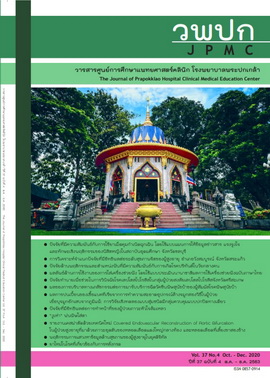Factors Related to Emergency Contraceptive Pill Use Based on the Information-Motivation-Behavioral Skills (IMB) Model among Female University Students in Chonburi Province
Main Article Content
Abstract
Background: Unintended pregnancy is an important public health issue affecting adolescents and is a consequence of contraceptive behavior, especially in terms of indiscriminate use of emergency contraceptive pills.
Objectives: This study aimed to examine factors related to emergency contraceptive pill use among female university students in Chon Buri Province based on the Information-Motivation-Behavioral Skills (IMB) Model.
Materials and methods: This cross-sectional study used multi-stage sampling to recruit 467 first- to fourth-year female students from an university in Chon Buri Province. Respondents completed the self-administered questionnaire from January-February 2019. Descriptive statistics were used to analyze the variables under investigation, and Chi-square was analyzed to assess any associations.
Results: Of the total sample of female university students, 51.8% were ≤ 20 years of age and 67.5% reported indiscriminate emergency contraceptive pill use. Factors significantly associated with emergency contraceptive pill use were: department of study (p = 0.03), sexual intercourse experience (p = 0.01), partner’s influence (p = 0.01), attitude toward emergency contraceptive pill use (p < 0.01), social media influence (p = 0.01), and personal capacity to access and use emergency contraceptive pills (p < 0.01).
Conclusion: This study showed that more pills. In order to increase female university students’ vigilance in their use of emergency contraceptive pills, universities should create policy aiming to increase motivation and behavioral skills that will result in fewer unintended pregnancies and more appropriate prevention of sexually transmitted diseases.
Article Details
References
National Statistical Office. Demography population and housing branch Bangkok: Ministry of Information and Commutation Technology [Internet]. 2018 [cited 2019 Mar 1]. Available from: http://statbbi.nso.go.th/staticreport/page/sector/en/01.aspx.
Thongnopakun S, Pumpaibool T, Somrongthong R. The effects of an educational program on knowledge, attitudes and intentions regarding condom and emergency contraceptive pill use among Thai female university students. Journal of Health Research 2018; 32:270-8.
Bureau of Reproductive Health. Birth Rate among Mothers aged 15-19 years in 2018 Nonthaburi: Ministry of Public Health [Internet]. 2018 [cited 2019 Mar 15]. Available from: https://bit.ly/2RuTItX.
Sananpanichkul P, Leaungsomnapa Y. Adolescent pregnancy : maternal factors effect on fetal outcomes. J Prapokklao Hosp Clin Med Educat Center 2015;32:147-56.
Ruangsiri K, Thongnopakun S. Factors related to intentions of the emergency contraceptive pill use among female university students in Chon Buri province. Academic Journal of Community Public Health 2018;4(2):63-75.
Dilokpattanamongkol P. Emergency contraceptive pill for women [Internet] 2016 [cited 2016 Dec19]. Available from: www.pharmacy.mahidol.ac.th/knowledge/files/0054.pdf
Fisher JD, Fisher WA. Theoretical approaches to individual-level change in HIV risk behavior. In: Peterson JL, DiClemente RJ, editior . Handbook of HIV prevention. New York: Springer; 2000. P. 3-55.
Fisher JD, Fisher WA, Shuper PA. The information-motivation-behavioral skills model of HIV preventive behavior. In: DiClemente RJ, Crosby RA, Kegler M. Emerging theories in health promotion practice and research. 2nd ed. San Francisco: John Wiley & Sons; 2009. P.21-64.
Cochran WG. Sampling techniques. New York: Wiley; 1965.
Best JW, Kahn JV. Research in education. 10th ed. Boston: Pearson Education, Inc, 2006.
DeVellis RF. Scale development: theory and applications. Chapel Hill: Sage Publications; 2016.
Thepa W. Factors related to the use of the emergency contraceptive pills among female adolescents [dissertation]. Bangkok: Mahidol University; 2014.
Fisher JD, Fisher WA. Changing AIDS-risk behavior. Psychol Bull 1992;111:455-74.
Sangsawang N, Sangsawang B, Wisarapun P. Attitude, awareness and characteristics of emergency contraceptive pill usage among adolescents. Journal of Medicine and Health Sciences 2016;23:15-25.
Pojanapotha P, Singhakant S, Kaewpornsawan T, Apinuntavech S. Attitudes and sex education associated with sexual behavior in Thai male students in Bangkok. J Public Health 2017;47:18-30.
Prata N, Bell S, Fraser A, Carvalho A, Neves I, Nieto-Andrade B. Partner support for family planning and modern contraceptive use in Luanda, Angola. Afr J Reprod Health 2017;21(2) :35-48.
García- Vega E, Rico R, Fernández P. Sex, gender roles and sexual attitudes in university students. Psicothema 2017;29:178-83.
Sangsawang N, Sangsawang B, Wisarapun P. Emergency contraception in adolescences. Journal of Medicine and Health Sciences 2016;23(1):45-54.
Kanjanasilp J, Ploylearmsang C, Rangseepanya A, Donnak C, Robpiree J. Effects of drug reminder application and manual for improving adherence of oral contraceptives. Thai Journal of Pharmacy Practice. 2018;10:88-99.
Jumklang S, Srisuriyawet R, Homsin P. Correlated factors with decision making of birth control implant used based on the information-motivation behavioral skills model (IMB Model) among teen mothers. The Journal of Faculty of Nursing Burapha University 2017; 25(2):31-42.

